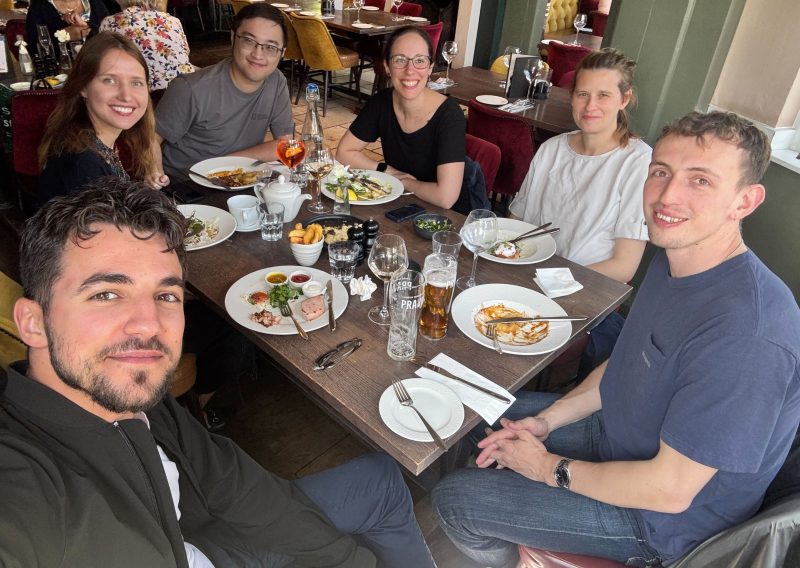Our research aims to understand the molecular basis of cell identity, and the transcriptional control mechanisms that determine diversity in cell fate choice during embryonic development.
“How do cells develop during early development?”
During embryonic development, different cell types will form to make up the body. But how does an embryo produce the right cell type, at the right position? Our group is examining how this processed is controlled. These insights are critical to understand how congenital diseases develop, including cancer, and are relevant for developing appropriate therapies, spanning tissue engineering and regenerative medicine.
The ability to make different cell types relies on the activity of different genes. Our lab is studying the control mechanisms that drive differential gene activity. To do this, we study the function of enhancers – discrete regions of the genome that act as molecular “switches” that help to determine where and when a gene is expressed. By studying enhancer function, we aim to explain how different cell types develop.
To achieve these goals, we use embryonic stem cells to study how different cell types develop in vitro, using mouse models to resolve how this translates in an in vivo setting. We combine these approaches with genome engineering and computational biology to define how different cell types are controlled by enhancers through the actions of different signalling cues that are perceived and interpreted by cells.
Understanding how cell identity is controlled holds the potential to address a range of biomedical questions, including how we have evolved to produce the wide array of cell types that make up the human body.

Defining the molecular basis of cell identity
Our lab is uncovering how diversity in cell identity arises during embryonic development. By exploring how cells take on distinct identities in the head versus the trunk of the body plan, we’ve made groundbreaking discoveries about the regulatory mechanisms that drive these regional differences. Our research has revealed crucial roles mediated by non-coding DNA elements, like enhancers, in regulating gene activity and directing cell identity, providing fundamental insights into the molecular processes that shape the body.
Our ambition is to define the molecular principles that determine cell type identity and diversity during development, by addressing key questions:
By developing strategies to engineer precise cell types, we aim to contribute valuable insights across fields spanning development, disease modelling and regenerative medicine.
Vicki Metzis holds a Sir Henry Dale Fellowship at Imperial College London.
Imperial profile: https://www.imperial.ac.uk/people/v.metzis
Our lab investigates how regulatory DNA sequences control gene expression during development.
Using mouse genetic models, and embryonic stem cells differentiated into defined cell types, we study the mechanisms that establish the mammalian body plan. By dissecting how regulatory DNA orchestrates these processes, we aim to uncover fundamental rules of cell fate specification, with direct relevance to engineering cell types on demand. This work is of growing importance as mutations in noncoding DNA sequences are increasingly recognised as a key driver of human disease, yet predictive frameworks to interpret their impact are lacking.
Through genome engineering and quantitative in vitro models, we are building platforms to connect regulatory sequence variation to developmental outcomes. These efforts open new opportunities for modelling human disease and ultimately for translating genomic discoveries into therapeutic strategies.
The Fascinating World of Developmental Biology – a 30 minute documentary from the British Society for Developmental Biology featuring imagery from our lab.




Amblard I, Baranasic D, Xie SQ, Moyon B, Percharde M, Lenhard B, Metzis V. A dual enhancer-attenuator element ensures transient Cdx2 expression during mouse posterior body formation, Dev. Cell (2025), [In press] https://doi.org/10.1016/j.devcel.2025.06.006
Needham J, Metzis V. (2022) Heads or tails: making the spinal cord. Dev Biol. 485:80-92. doi: 10.1016/j.ydbio.2022.03.002
Blassberg R, Patel H, Watson T, Gouti M, Metzis V, Delás MJ, Briscoe J. Sox2 levels regulate the chromatin occupancy of WNT mediators in epiblast progenitors responsible for vertebrate body formation. Nat Cell Biol. 2022;24(5):633-644. doi: 10.1038/s41556-022-00910-2
Binagui-Casas A, Dias A, Guillot C, Metzis V, Saunders D. Building consensus in neuromesodermal research: Current advances and future biomedical perspectives. Curr Opin Cell Biol. 2021;73:133-140. doi: 10.1016/j.ceb.2021.08.003
Exelby K, Herrera-Delgado E, Garcia Perez L, Perez-Carrasco R, Sagner A, Metzis V, Sollich P, Briscoe J. (2021) Precision of Tissue Patterning is Controlled by Dynamical Properties of Gene Regulatory Networks. Development 148 (4): dev197566.
Semprich CI, Metzis V, Patel H, Briscoe J, Storey KG (2019). ERK1/2 signalling dynamics promote neural differentiation by regulating the polycomb repressive complex. bioRxiv 2019;586719.
Metzis V, Steinhauser S, Pakanavicius E, Gouti M, Stamataki D, Ivanovitch K, Watson T, Rayon T, Mousavy Gharavy SN, Lovell-Badge R, Luscombe NM, Briscoe J. (2018). Nervous System Regionalization Entails Axial Allocation before Neural Differentiation. Cell;175(4):1105-1118.e17
Gabrysova L, Alvarez-Martinez M, Luisier R, Cox LS, Sodenkamp J, Hosking C, Perez-Mazliah D, Whicher C, Kannan Y, Potempa K, Wu X, Bhaw L, Wende H, Sieweke MH, Elgar G, Wilson M, Briscoe J, Metzis V, et al. (2018). c-Maf controls immune responses by regulating disease-specific gene networks and repressing IL-2 in CD4(+) T cells. Nature Immunology;19(5):497-507.
Lu H, Galeano MCR, Ott E, Kaeslin G, Kausalya PJ, Kramer C, Ortiz-Bruchle N, Hilger N, Metzis V, Hiersche M, et al. (2017). Mutations in DZIP1L, which encodes a ciliary-transition-zone protein, cause autosomal recessive polycystic kidney disease. Nature Genetics;49(7):1025-1034
Gouti M, Metzis V, Briscoe J. (2015). The route to spinal cord cell types: a tale of signals and switches. Trends Genet;31(6):282-9.
Metzis V, Courtney AD, Kerr MC, Ferguson C, Rondon Galeano MC, Parton RG, Wainwright BJ, Wicking C. (2013). Patched1 is required in neural crest cells for the prevention of orofacial clefts. Human Molecular Genetics;22:5026-5035
Butterfield NC, Metzis V, McGlinn E, Bruce SJ, Wainwright BJ, Wicking C. (2009). Patched 1 is a crucial determinant of asymmetry and digit number in the vertebrate limb. Development;136: 3515-3524